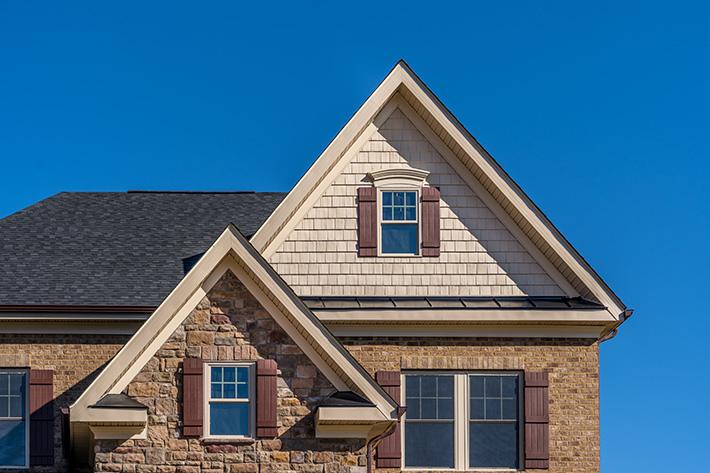If you don’t know your roof deck from your underlayment, you are not alone. Most homeowners don’t know much about the roofs over their heads except that when their roofs fail, they have trouble. It is hard to communicate with a roofing sales representative or an installer if you don’t have a basic understanding of the major parts that make up a residential roof.
Knowing about your roof helps with your overall home improvement checklist by making sure all areas are taken care of properly.
Roof Shingles
Roof shingles are the covering that you see when looking at a home. They consist of “individual overlapping elements which are typically flat, rectangular shapes laid in courses from the bottom edge of the roof up, with each successive course overlapping the joints below.”1
You would probably be shocked to know that there are at least 23 different types of roof shingles on the market today. The list includes three-tab asphalt, architectural, hip and ridge, metal standing seam, metal shake, sheet metal, wood, ceramic tile, metal tile, concrete tile, bituminous tile, polymer-sand tile, copper tile, composite tile, slate, rubber, laminate, copper sheet, living (green roof), solar shingles, impact-resistant shingles, cool-roofing shingles and PVC shingles.2
The top six most popular shingle materials are asphalt, clay and concrete tiles (which are primarily used on southwestern and Spanish-style homes), metal, slate, wood shingles and shake, and synthetic roofing products made to look like slate and wood.3
Asphalt shingles remain the most popular with homeowners as they are easy to install, generally last 20 to 25 years, and are less expensive than other roofing materials such as slate, tile and metal.4 There are two main types of asphalt shingles generally used: thee-tab and architectural (or they can also be referred to as three-dimensional or laminated shingles).
Three-tab shingles lay flat on the roof while architectural shingles contain more than one layer of tabs which add dimension, performance and durability to a roof.5
Roofing Underlayment
Directly under the shingles that you see is the roofing underlayment. This is a layer of material, usually synthetic or felt, which repels moisture and water. Synthetic underlayment is more durable than felt and provides added water resistance so it is becoming increasingly popular with installers.
Roof Deck
The roofing underlayment sits on the roof deck, which is the structural foundation base for the roof system and is usually made of wood, plywood or oriented strand board (OSB).
Ice and Water Barrier
The ice and water barrier is actually a leak barrier that blocks water from backing up behind an ice dam and leaking into a home.6 This leak barrier is commonly installed along eaves, valleys, side walls and other sensitive areas to protect against ice and rain damage.
Local building codes mandate how wide the leak barrier should be depending on the slope of your roof, with the minimum typically being 24″ and the average being about 36″.7
Eave and Metal Drip Edge
The eave is the section of the roof that overhangs a wall and is usually located in the first three feet from the edge of a roof. At the edge of the eave is a narrow strip of metal, called the metal drip edge, which is installed to manage water runoff so that water doesn’t infiltrate the wall.
Roof Ridge, Ridge Vent and Hip
The very top of the roof where the two main slopes of the roof join together is called the roof ridge. A ridge vent is often installed on the roof ridge to allow warm, humid air to escape from the attic. Special shingles, called ridge shingles, are used in the ridge area.
The hip refers to a portion of the roof where two roof planes meet to form a sloping ridge running from the peak to the eave. Special shingles are also used in the hip area and are referred to as hip shingles.
Flashing
Flashing is metal material that is installed around any opening in the roof such as a skylight, dormer window, chimney or any other opening. Flashing is an added layer of protection against water damage.
Find a Good Roofing Contractor
Feel free to ask your roofing sales representative or installer to clarify any roofing or construction terms that you don’t understand. Good communication is essential to ensuring your satisfaction and contractors know that homeowners aren’t generally knowledgeable on terms related to roof installations or replacements.
In order for a roof to serve its purpose, it needs to be installed properly as well as maintained. That’s where Excel Home Improvement in Romulus can help. Our home improvements services include roof installation and repair, as well as gutter installation, siding installation and repair services and so much more.
We have earned a trusted name in the industry due to our high-quality work, skill and materials. Michigan homes face unpredictable weather that can yield devastating results to a home’s exterior so it’s essential your siding, gutters and especially your roof are prepared. So if you need exterior home improvement services and want a dependable contractor, call us and see why we are a popular choice!
____________________________
1 Roof Shingle: Definition
Link: https://en.wikipedia.org/wiki/Roof_shingle
2 23 Different Types of Roofing Shingles (2023): Pros, Cons and Costs of Each, 1/4/2023
Link: https://www.homestratosphere.com/types-roof-shingles/
3,4 Top 6 Roofing Materials by Jeannie Matteucci
Link: https://www.hgtv.com/outdoors/outdoor-remodel/top-6-roofing-materials
5 The Anatomy of a Roof
Link: https://www.owenscorning.com/en-us/roofing/tools/the-anatomy-of-a-roof
6 Ice Barriers Explained: What Materials Can You Use? by Mike Guertin
Link: ttps://www.finehomebuilding.com/project-guides/roofing/ice-barriers-explained-materials-can-use#
7 Ice and Water Protector: What is it and Where Does it Go?
Link: https://www.iko.com/na/learning-center/roofing-101/what-is-an-ice-and-water-protector/
6 How Long Do Metal Roofs Last? by Kaylee Beattle, 9/7/2021
Link: https://www.bridgersteel.com/blog/how-long-do-metal-roofs-last#

